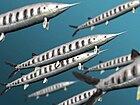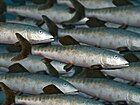
Osteoglossidae is a family of large-sized freshwater fish, which includes the arowanas. They are commonly known as bonytongues. The family has been regarded as containing two extant subfamilies Arapaiminae and Osteoglossinae, with a total of five living genera, but these are regarded as valid families in Eschmeyer's Catalog of Fishes The extinct Phareodontinae are known from worldwide during the Late Cretaceous and Paleogene; they are generally considered to be crown group osteoglossids that are more closely related to one of the extant osteoglossid subfamilies than the other, though their exact position varies.

Lycoptera is an extinct genus of fish that lived from Lower Cretaceous, Barremian to Aptian in present-day China, North Korea, Mongolia and Siberia. Although there is record from Jurassic Formation in Siberia, its age remains questionable. It is known from abundant fossils representing sixteen species, which serve as important index fossil used to date geologic formations in China. Along with the genus Peipiaosteus, Lycoptera has been considered a defining member of the Jehol Biota, a prehistoric ecosystem famous for its feathered dinosaurs, which flourished for 20 million years during the Early Cretaceous, where it occurs abundantly in often monospecific beds, where they are thought to have died in seasonal mass death events. Lycoptera is a crown group teleost belonging to an early diverging lineage of the Osteoglossomorpha, which contains living mooneyes, arapaima, arowana, elephantfish and knifefish/featherbacks.
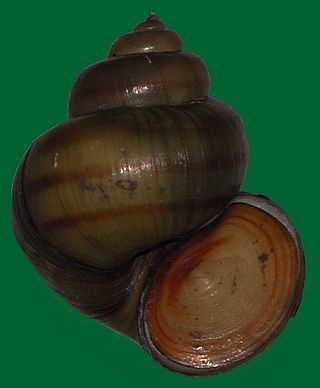
Viviparidae, sometimes known as the river snails or mystery snails, are a family of large aquatic gastropod mollusks, being some of the most widely distributed operculate freshwater snails.

Uarbryichthys is a genus of primitive ginglymodian ray-finned fish from fossil beds near the Talbragar River Bed. The various species were lake-dwelling fish that lived during the Upper Jurassic of Australia, and are closely related to the macrosemiids. The living animal would have had a superficial resemblance to a very small porgie, scup, or sea bream, but with a heterocercal tail fin.
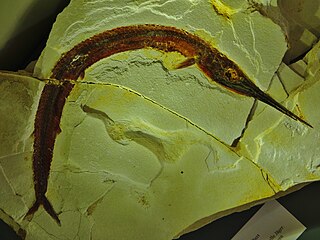
Aspidorhynchidae is an extinct family of ray-finned fish from the Mesozoic Era. It is the only member of the monotypic order Aspidorhynchiformes. Members of the group are noted for their elongated, conical rostrums, of varying length, formed from fused premaxillae. The range of the group extends from the Middle Jurassic to the end of the Maastrichtian, with a potential record from the Late Paleocene. The family and order were described by Pieter Bleeker in 1859.
Baleiichthys is a genus of extinct freshwater ray-finned fish, belonging to the teleosts. It lived in the Middle Jurassic, and its fossil remains have been found in northern Asia. Almost nothing is known about it.
Oreochima is an archaeomaenid ray-finned fish from Lower Jurassic-aged freshwater strata of Queen Alexandra Range, Antarctica. Fossils come from the Lower Jurassic Mawson Formation (Toarcian) of Storm Peak, Antarctica, where a freshwater lake system, called "Lake Carapace", once existed. O. ellioti is also notable for being one of few archaeomaenid genera found outside of Australia, as well for be one of the oldest members of the family.
Aetheolepis is an extinct genus of ray-finned fish which lived in freshwater environments in what is now Western Australia and New South Wales during the Jurassic period. It contains one species, A. mirabilis. Aetheolepis was previously thought to be an archaeomaenid, until a 2016 study instead recovered it as a member of the family Dapediidae. Like other dapediids, it had a deep, discoid-shaped body. Fossils of A. mirabilis have been found in the Talbragar River fossil beds of New South Wales and the Colalura Sandstone of Western Australia. It was named by Arthur Smith Woodward in 1865 along with other Talbragar fish.

Dictyopyge is an extinct genus of prehistoric freshwater ray-finned fish that inhabited eastern North America during the early part of the Late Triassic. Two species are recognized, both from the early Carnian-aged Doswell Formation in what is now Virginia, United States:
Chrotichthys is an extinct genus of prehistoric freshwater ray-finned fish that lived in the Anisian stage of the Middle Triassic epoch. It contains a single species, C. gregarius, known from the Terrigal Formation of New South Wales, Australia.
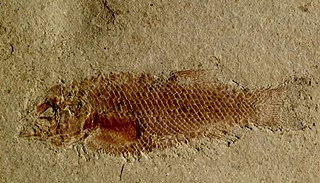
Acentrophorus is an extinct genus of prehistoric freshwater and marine ray-finned fish from the Roadian to the Wuchiapingian of England, Germany (Kupferschiefer), Italy and Russia. There may also be a Triassic occurrence in Australia.

Anaethalion is an extinct genus of prehistoric marine and freshwater ray-finned fish related to modern tarpons and ladyfish. It is known from the Late Jurassic to the Early Cretaceous of Europe and northeasterrn Asia, roughly encompassing the Tethys Ocean.

Archaeomaene is an extinct genus of freshwater ray-finned fish that lived in what is now Australia during the Late Jurassic. It is a monotypic genus, containing only the species Archaeomaene tenuis, which is known from the Talbragar River beds of New South Wales.
Ceramurus is an extinct genus of prehistoric marine ray-finned fish from the Late Jurassic. It contains a single species, C. macrocephalus from the Purbeck Group of England.
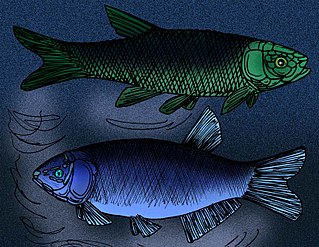
Wadeichthys oxyops is an extinct archaeomaenid bony fish from the Koonwarra Lake fauna of Lower Cretaceous Victoria, Australia. If the related genus Koonwarria is regarded as being in a different family, then W. oxyops is the only known Cretaceous-aged archaeomaenid from Australia.

Cavenderichthys is an extinct genus of prehistoric freshwater ray-finned fish from the Late Jurassic. It contains a single species, C. talbragarensis from the Talbragar Fish beds of New South Wales, Australia.

The Talbragar fossil site is a paleontological site of Late Jurassic (Tithonian) age in the central west of New South Wales, Australia. It lies about 30 kilometres (19 mi) north-east of the town of Gulgong, and 300 kilometres (190 mi) north-west of Sydney. The site has been known for over a century during which it has been extensively excavated to the point of near exhaustion. It is now registered as a Crown Land Reserve for the preservation of fossils; access is by permit, and the collection of rocks and fossil specimens is prohibited. The 4-hectare (9.9-acre) reserve is listed on the Register of the National Estate.

Archaeomaenidae is an extinct family of stem-teleost fish found in freshwater environments of Jurassic New South Wales of Australia, China, and Antarctica, and in Lower Cretaceous New South Wales and Mongolia.

"Agathis" jurassica is an extinct coniferous tree found in the Talbragar Fish Beds of New South Wales. The beds were discovered in 1889 near the Farrs Hills in the Talbragar River valley. Specimens from the area were briefly examined by Australian palaeontologists upon discovery and published by R. Etheridge Jr. later that year. The initial classification identified Agathis jurassica as Podozamites lanceolatus. This name was upheld through further inspections by Walkom in 1921, but the species was reclassified as Agathis jurassica in 1981 by Mary White. In 1999, placement in Agathis was doubted, and the species has been referred to as Podozamites jurassica. The species is found predominantly in the Southern Hemisphere with marginal expanses into the Northern Hemisphere.

Pholidophoridae is an extinct family of primitive stem-teleost fish that lived during the Triassic period, from the Anisian age of the Middle Triassic to the Norian age of the Late Triassic. Most of the genera are from Europe, but one (Malingichthys) is known from China. The pholidophorids were historically united with several other stem-teleost lineages into the order Pholidophoriformes, but Pholidophoriformes in its traditional sense is now considered paraphyletic with respect to crown group teleosts.















